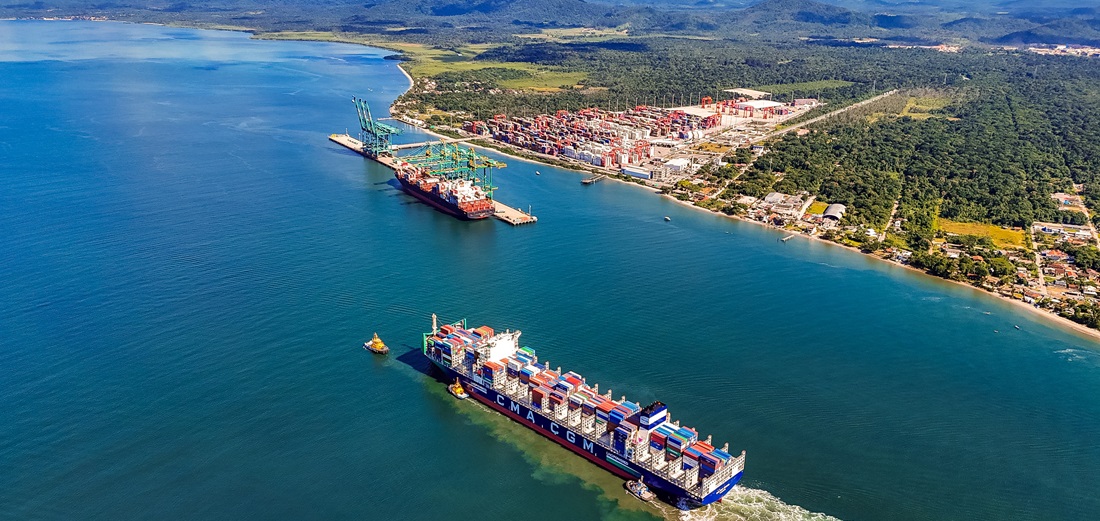
Porto Itapoá Announces Ambitious Expansion Plan Aiming South America’s Top Spot by 2023
Sep, 27, 2024 Posted by Gabriel MalheirosWeek 202438
Porto Itapoá, a major Brazilian port, has unveiled on September 26 a new phase of its expansion project, involving a substantial investment of R$500 million. This latest investment will see the acquisition of new equipment and a significant expansion of its operational area. With this expansion, the terminal aims to become the largest container port in South America by 2033, a title currently held by the Port of Santos.
The announcement was made in Itajaí, during the Itapoá Day, essentially on the “home turf” of its main competitor. The Itajaí-Açu Port Complex, which encompasses both the ports of Itajaí and Navegantes, currently ranks second in Brazil for container throughput.
This latest expansion phase marks the fourth stage of a broader project aimed at significantly increasing the port’s capacity. Coupled with previously announced and ongoing investments, the total investment in the project now stands at R$3 billion.
Key elements of the fourth phase include modernizing port gates, adding an additional 120,000 square meters of operational area, and acquiring new equipment, including an eighth ship-to-shore (STS) crane and 12 rubber-tired gantry cranes (RTGs). Construction is already underway, and completion is expected in 2025.
Felipe Fioravanti Kaufmann, the port’s Business Development Director, explained that these investments are driven by market demand. “The market demands increased capacity. Today, from Santos to Rio Grande, we handle 8.6 million TEUs. By 2040, this figure is expected to reach 15 million,” he stated.
Porto Itapoá offers several competitive advantages, including ample space for expansion and deep-water access, unlike the Itajaí-Açu Port Complex, which is constrained by a river channel. However, the port has faced limitations regarding the size of vessels it can accommodate. Recently, the port secured a seven-year-old environmental permit for dredging the access channel to Babitonga Bay, which will allow for larger vessels of up to 366 meters in length.
“We are operationally prepared to receive 400-meter vessels, for example, in terms of crane size. What we lack is the necessary waterway,” said Kaufmann.
The dredging project, undertaken in partnership with the state government, will be financed by the private port. Due to the innovative financing model, the operation is still pending approval from the Ministry of Ports and Airports.
The chart below uses DataLiner-derived data to compare monthly animal protein (pork, beef, and poultry) exports from the Port of Itapoá between January and July in the first four years.
Meat Exports from Itapoá Port | 2021 to 2024 | TEUs
Source: DataLiner (click here to request a demo)
Challenges and Opportunities
The port faces challenges related to land access, particularly on state highways connecting the terminal to federal highways BR-101 and BR-280. The state government is expected to invest in improvements to enhance the flow of container traffic and meet the growing demand.
Despite these challenges, Porto Itapoá has experienced significant growth. In 2024, the port recorded its best-ever first half, handling 597,000 TEUs, a 12% increase compared to the same period in 2023. Its primary competitor in Santa Catarina is Portonave in Navegantes.
Source: NSC Total
Click here to read the original text: https://www.nsctotal.com.br/colunistas/dagmara-spautz/o-porto-de-sc-que-projeta-engolir-santos-e-se-tornar-o-maior-da-america-do-sul
-
Coffee
Dec, 05, 2022
0
Coffee: Brazil brings November to a close with 3.607 mln bags shipped
-
Shipping
Mar, 27, 2019
0
CMA CGM, Cosco and Evergreen become vessel providers for SSA service
-
Coffee
Jan, 29, 2025
0
Instant Coffee Exports Grow 13% in 2024
-
Ports and Terminals
Jul, 04, 2024
0
Port of Rio Grande begins dredging access channel hit by floods

